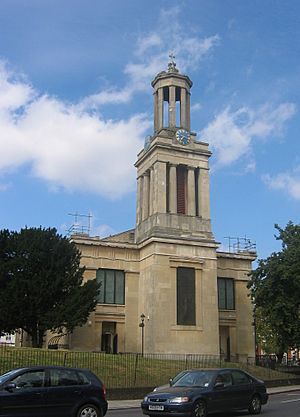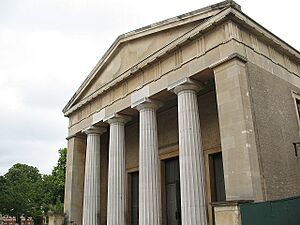St Matthew's Church, Brixton facts for kids
Quick facts for kids St Matthew’s Church, Brixton |
|
|---|---|
 |
|
| Denomination | Church of England |
| Website | http://www.stmatthewsbrixton.org/ |
| History | |
| Dedication | St Matthew |
| Architecture | |
| Architect(s) | Charles Ferdinand Porden |
| Groundbreaking | 1 July 1822 |
| Completed | 21 June 1824 |
| Administration | |
| Parish | Brixton St Matthew with St Jude |
| Deanery | Lambeth North |
| Archdeaconry | Lambeth |
| Episcopal area | Kingston |
| Diocese | Southwark |
| Province | Canterbury |
St Matthew's Church is a Church of England church located in Brixton, a part of London. It is a very important historical building, known as a Grade II* listed building. This means it's protected because of its special history and architecture. The church stands in a noticeable spot where Brixton Road, Brixton Hill, and Effra Road meet. It was built after a special law in 1818 and opened in 1824.
Contents
A Church for the Community
Why St Matthew's Was Built
Before St Matthew's Church was built, Brixton was part of a much larger area called Lambeth. The main church for Lambeth was about 3 miles (5 km) away. This was difficult for people living in Brixton, especially as new homes were being built. To help, four new churches were planned, and St Matthew's in Brixton was one of them.
When St Matthew's opened in 1824, it became the center of its own "parish." A parish is like a local area that a church serves. St Matthew's parish covered Brixton, Brixton Hill, Herne Hill, Tulse Hill, and parts of Loughborough Junction and Camberwell.
Growing Community and Music
In the late 1800s and early 1900s, many people lived in the St Matthew's parish. The church was a busy place with several clergy members. It also had its own amateur orchestra and choir. They put on many concerts, performing big musical pieces. This shows how important music was to the church and its community.
In 2002, St Matthew's parish joined with St Jude's parish. St Jude's church building had been sold earlier, and it no longer had a vicar. This union helped both communities.
The number of people living in the parish has grown over time. In 2001, about 12,100 people lived there. By 2011, this number had increased to around 15,500 people.
The Church Building
How It Was Built
St Matthew's Church was built because of the Church Building Act 1818. This law made it easier to build new churches in areas where many people lived. The land for the church was taken from a common area called Rush Common. Work started in late 1821. The first stone, called the foundation stone, was laid on July 1, 1822, by the Archbishop of Canterbury. The church was officially ready and "consecrated" (made sacred) in 1824.
Design and Features
Since 1951, St Matthew's Church has been a Grade II* listed building. This means it's a very important historical building that needs to be preserved. The church was designed by an architect named Charles Ferdinand Porden.
The building is shaped like a rectangle. At the west end, facing Brixton Hill, there's a large entrance with tall, strong columns. This part is called a Greek Doric portico. A tall tower stands at the east end of the building.
Over the years, especially in the 1970s, the inside of the church was changed. These changes created more space for different activities, while still allowing the Anglican church services to continue.
The church and its churchyard are on a triangular piece of land where several main roads meet. It's easy to see, but getting to it on foot can be tricky because of the wide, busy roads.
Architectural Style
The church is built on a stone base. It uses yellow bricks with special stone decorations and a material called Roman cement. The main entrance has three large doors. These doors still have their original cast iron boot scrapers, which people used to clean their shoes.
The sides of the church have five sections with flat columns called pilasters. You can go down stairs to the crypt (an underground room) through doors protected by wrought iron gates. The tower has a square section for bells. Above that, it has an eight-sided top, like a "Tower of the Winds," with a clock at its base and a crown and cross at the very top.
Famous Connections
A well-known person, John Major, who later became the Prime Minister of Britain, married his wife, Norma Major, in this church in 1970.


